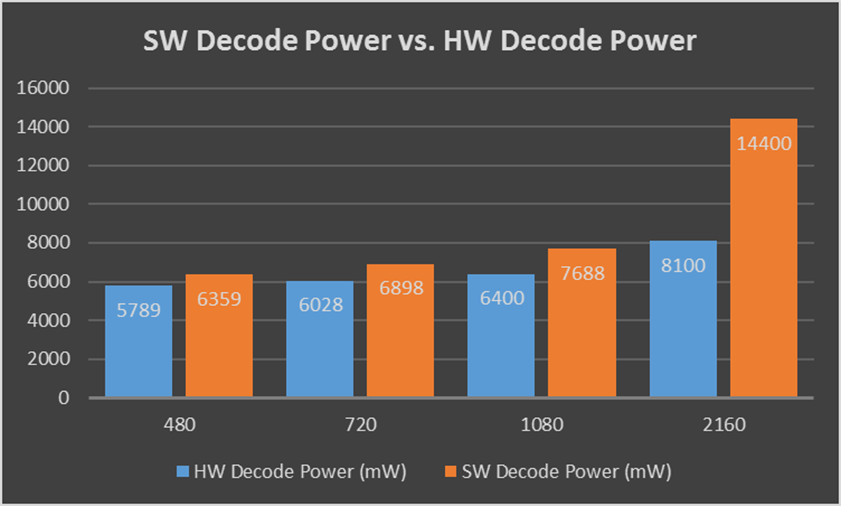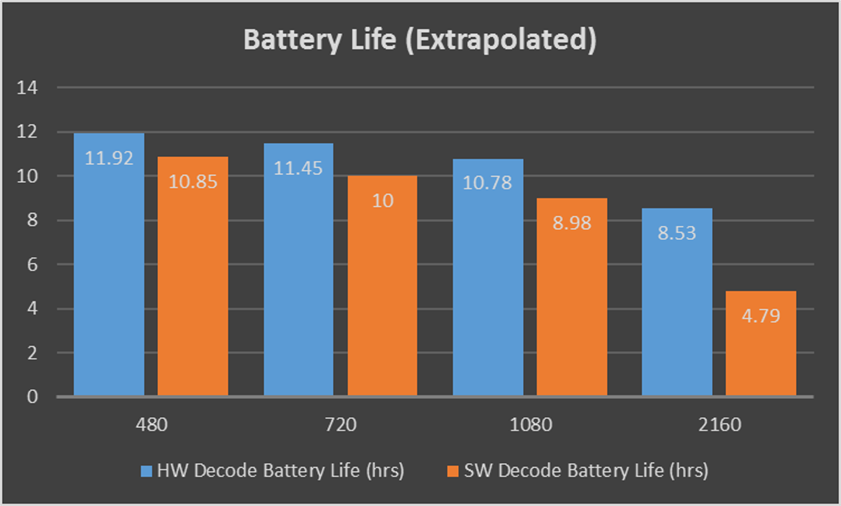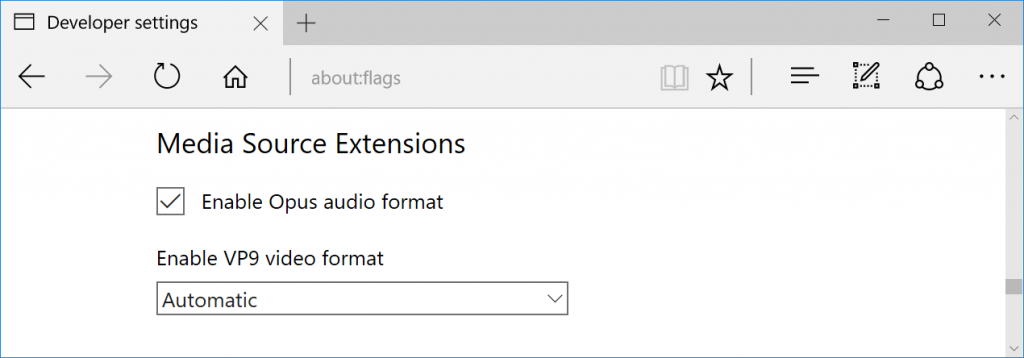VP9 is an efficient open source video codec developed as part of the WebM Project by Google. The VP9 and WebM project team recently joined the Alliance for Open Media effort where their work on VP9 is expected to be a significant contribution to the next generation of open-source, royalty-free video codecs.
Opus was developed by the Xiph Foundation to support both bandwidth-efficient speech/RTC applications as well as high-quality media playback – all within one codec. Opus is the primary audio codec paired with VP9 in the WebM specification.
We are adding support for these formats to simplify building interoperable websites, and to provide an alternative format for compressing 4K video content. To try them in Microsoft Edge, please install the most recent Windows 10 Insider Build.
Background
Microsoft has been providing support for Media Source Extensions (MSE) since Windows 8.1, initially through support for ISO-Base Media File Format (ISO-BMFF) content that uses fragmented MP4 containers with H.264/AVC video and AAC audio. More recently, we added support within MP4 for H.265/HEVC video and Dolby Digital multi-channel audio, formats targeted at high-performance media.
The WebM Byte Stream Format has existed for some time. It defines the specifics of using VP9 and Opus with MSE. VP9 is an open source video codec that has efficient compression well suited to HD and 4K streaming. Opus, similarly, is a very efficient open source audio codec. They are used together by some prominent websites – notably YouTube – that value them for this efficiency, especially on content with greater than 1080p resolution. Adding WebM, VP9 and Opus to Microsoft Edge means the full experience on these websites will be possible in the Edge browser.
VP9 and Opus Performance
Our implementation of VP9 will support software decoding and, when supported by the device, hardware decoding via the DXVA interface. Video decoding is computationally complex, so the best experience will be seen on computers that have VP9 hardware acceleration which is optimized for 4K decoding support, a feature which will start to become common on devices later this year. Software decoding can yield good performance, but will work best on more powerful desktop or laptop computers.
There’s a side effect of high computing load on software decode: system power consumption is elevated. The elevation is highest on 4K content because the computing load correlates closely with video resolution. If we compare software decode to hardware accelerated decode, software decode may consume 20% more total power when viewing a 1080p video, and up to 80% more power viewing 2160p. The following charts compare hardware video decode to software video decode at different resolutions on a mid-level laptop computer:
This difference in power consumption is important because hardware acceleration is common for H.264, but not yet for VP9. If websites see VP9 is supported, they may prioritize using it and users will experience an unexplained reduction in battery life.
Ideally, there would be a way for apps to confirm hardware acceleration itself is supported. Current web specifications don’t allow for this. For this reason, we’ve put VP9 behind an experimental flag in Microsoft Edge, and have provided a default setting for it that automatically enables VP9 when hardware acceleration is detected. VP9 is not supported on Windows mobile SKUs at this time.
Audio codecs, Opus included, don’t have the same power concern and are usually decoded in software. We have, however, elected to put Opus behind an experimental flag as well. Opus is supported on Windows mobile and desktop SKUs.
Managing Experimental Flags
You can manage the settings for VP9 and Opus by navigating to about:flags in the address bar.
Flags may be used to change the default settings for VP9 and Opus. These default settings are:
- Opus: Enabled
- VP9: Automatic
The “Automatic” setting for VP9 enables VP9 if hardware acceleration is supported on the device. We did this for the power reason previously discussed as well as the potential on less powerful computers to experience frame drops when doing software decode on higher resolution streams. The full set of VP9 flag settings and their meaning are:
- Automatic: VP9 is enabled if hardware-accelerated VP9 decoding is supported
- Enabled: VP9 is always enabled and available for use
- Disabled: VP9 is always disabled
These settings allow users to have VP9 always enabled or disabled, in addition to our default setting. We encourage experimenting with these settings and look forward to your feedback.
The “Enabled” default setting for Opus means the Opus codec will be enabled and available for website use, and will show up in the MSE MediaSource.isTypeSupported capabilities query. It’s possible to disable Opus using this flag, which would make it unavailable for playback and show as unsupported via isTypeSupported().
VP8 video and Opus audio are important formats for WebRTC support, and have different considerations regarding hardware acceleration. The Edge WebRTC implementation supports VP8 and Opus regardless of the flag settings. See Roadmap update for Real Time Communications in Microsoft Edge for more information.
Integration
VP9 and Opus support can be queried by websites. With VP9 and Opus enabled, the following Media Source Extension capability checks will return “true”:
isTypeSupported ('video/webm; codecs="vp9"')isTypeSupported ('video/webm; codecs="vp9, opus"')isTypeSupported ('video/webm; codecs="opus"')isTypeSupported ('audio/webm; codecs="opus"')
And these will return “false”:
isTypeSupported ('video/webm')isTypeSupported ('audio/webm')
If VP9 is on “Automatic”, it will show up as supported on systems that have VP9 hardware acceleration, and won’t on systems that don’t.
MediaElement.canPlayType() is used to check capabilities for file-based playback. Edge will respond to any WebM canPlayType() calls with an empty string (the defined response for “not supported”) since we are only supporting WebM on MSE right now.
Microsoft has an ongoing effort to expand codec offerings in Windows. WebM, VP9, and Opus are our latest format additions. We continue to evaluate other formats and look forward to receiving feedback as we work on implementing them.
Please send us your feedback so we can further improve our media support in Microsoft Edge!
– Andy Glass, Principal Program Manager, Silicon, Graphics & Media (VP9 video)
– Neil Hinnant, Program Manager, Silicon, Graphics & Media (Opus audio)
– Jerry Smith, Senior Program Manager, Microsoft Edge (Media)



